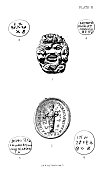
Sacred Texts Gnosticism Index Previous Next
Buy this Book at Amazon.com


The Gnostics and Their Remains, by Charles William King, [1887], at sacred-texts.com

Click to enlarge
Plate N
1. Universal Nature, symbolised in a highly poetic manner, combining all her forces for the protection of the bearer. The Eagle of Jupiter (Air); the Dolphins of Neptune (Water); the Lion of Sol (Fire), are moulded into the mask of Pan, whose semi-bestial nature is of the Earth, earthy.
Winckelmann, in describing an intaglio of the Stosch Cabinet (No. 1232) Pan, playing upon his syrinx, seated in the centre of the Zodiac, observes that the ancients considered this god as the "Type of the Universe"; and saw in his horns and shaggy hairs mystic allusions to the solar rays. For the same reason Apollo shared his Gryphon with Pan, and Orpheus sings of him as "Attuning the harmony of the world with his sportive music." Onyx cameo (Rollin and Feuardent).
2. Isis, standing, with the Asp, badge of royalty, rising from her forehead. The Coptic legend opens with the name of Osiris. The characters in the inner circle seem to be Demotic--they are not Palmyrene. I have published this gem, as being the finest example of the class that has ever come to my knowledge, by the kind permission of its owner, Mr. J. C. Robinson. Dark jasper. (On the reverse, a later hand has inscribed the "Great Name," and the Seven Vowels, to adapt the talisman to the new creed.)
Nos. 3 and 6 are very frequent forms, made up entirely of siglae and Numerals; on which latter subject more shall be said further on.
4. This spell, "Great is the Name of the One God," is the Jewish defiance to its rival, "Great is the Name of Serapis,"--of which Caylus publishes a beautiful example, in relief, of antique paste--a material that indicates a large manufacture of the same article to meet a constant demand.
5. Certain astral Powers, represented by their then well-known symbols, are enlisted, by this engraving, in the service of a lady, Sabinia Quinta. A popular kind of talisman this; another very similar is known to me, made for the benefit of one Victorina.
Pythagoras is perpetually referred to by Hippolytus as the real master of the Gnostics in the application of Numerals to the expression of things divine. He is known to have learned his system in Egypt; and necessarily brought away with him the cyphers which he found employed for the same purpose amongst his teachers. The primitive Egyptian numerals were of the simplest nature, but their abbreviations ultimately became distinct symbolical cyphers for the several days of the months; and out of these cyphers the Arabs composed their own system of notation. Hence it follows that many of the Gnostic siglæ may be no more than numerals connected with the astrological use of the charm on which they occur. In fact, Porphyry says of Pythagoras (in his Life') that his famous 'Numbers' were merely hieroglyphs, whereby he expressed ideas connected with his own philosophy. The so-called "Pythagorean Numerals"
are shown in the MSS. of Boethius's Geometry, composed in the sixth century. And that the "Numbers" of Pythagoras were Ten. appears from the remark of Aristotle (Met. vii. 8) "that some philosophers maintained that ideas and numbers were of the same nature, and amount to Ten in all."
That the Numerals as written down by "the last of the Romans," were Egyptian demotic characters in their origin is a very probable conjecture; but it is a curious fact, and remarkably confirms what has been said above, that several of them when viewed upside down assume the exact form of our present Arabic cyphers.